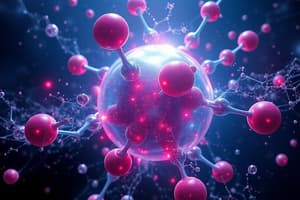Podcast
Questions and Answers
Which process involves breaking down complex molecules into smaller units using water?
Which process involves breaking down complex molecules into smaller units using water?
- Dehydration
- Hydrolysis (correct)
- Reduction
- Oxidation
Hydrogen gas, produced from the reaction of water with active metals, is commonly used as a refrigerant.
Hydrogen gas, produced from the reaction of water with active metals, is commonly used as a refrigerant.
False (B)
What type of reaction occurs when an oxidizing substance reacts with a reducing substance?
What type of reaction occurs when an oxidizing substance reacts with a reducing substance?
Redox reaction
Calcium Hydroxide, also known as _______ ,is used as a flocculant in wastewater treatment.
Calcium Hydroxide, also known as _______ ,is used as a flocculant in wastewater treatment.
What type of solution is formed when water reacts with non-metal oxides?
What type of solution is formed when water reacts with non-metal oxides?
Match the solid type with its description:
Match the solid type with its description:
Which of the following is a characteristic of amorphous solids?
Which of the following is a characteristic of amorphous solids?
Copper (II) Sulfate, a hydrate solution, typically contains how many molecules of water?
Copper (II) Sulfate, a hydrate solution, typically contains how many molecules of water?
Which type of intermolecular force is primarily responsible for the attraction between water molecules and sodium chloride (NaCl) in a solution?
Which type of intermolecular force is primarily responsible for the attraction between water molecules and sodium chloride (NaCl) in a solution?
Increasing the temperature of a liquid will generally increase its surface tension.
Increasing the temperature of a liquid will generally increase its surface tension.
Explain why soap can be used to remove oily stains, referencing its effect on intermolecular forces.
Explain why soap can be used to remove oily stains, referencing its effect on intermolecular forces.
The resistance of a liquid to flow is known as ______.
The resistance of a liquid to flow is known as ______.
Match the following properties of liquids with how they change with increasing temperature:
Match the following properties of liquids with how they change with increasing temperature:
Which of the following best describes the key difference between boiling and evaporation?
Which of the following best describes the key difference between boiling and evaporation?
If the temperature decreases, the vapor pressure of a liquid will increase.
If the temperature decreases, the vapor pressure of a liquid will increase.
Which intermolecular force is present in all types of molecules, regardless of their polarity?
Which intermolecular force is present in all types of molecules, regardless of their polarity?
Flashcards
Hydrolysis
Hydrolysis
The process of splitting complex molecules into smaller units using water.
Properties of Water
Properties of Water
Water is clear, odorless, tasteless, and colorless; impurities affect its qualities.
Hydrogen Gas
Hydrogen Gas
A highly reactive gas used in rocket fuel, welding, and balloons.
Redox Reaction
Redox Reaction
Signup and view all the flashcards
Crystalline Solid
Crystalline Solid
Signup and view all the flashcards
Amorphous Solid
Amorphous Solid
Signup and view all the flashcards
Water of Hydration
Water of Hydration
Signup and view all the flashcards
Calcium Hydroxide
Calcium Hydroxide
Signup and view all the flashcards
Kinetic Molecular Model: Solid
Kinetic Molecular Model: Solid
Signup and view all the flashcards
Kinetic Molecular Model: Liquid
Kinetic Molecular Model: Liquid
Signup and view all the flashcards
Kinetic Molecular Model: Gas
Kinetic Molecular Model: Gas
Signup and view all the flashcards
Dipole-Dipole Forces
Dipole-Dipole Forces
Signup and view all the flashcards
Hydrogen Bonding
Hydrogen Bonding
Signup and view all the flashcards
Surface Tension
Surface Tension
Signup and view all the flashcards
Viscosity
Viscosity
Signup and view all the flashcards
Boiling Point
Boiling Point
Signup and view all the flashcards
Study Notes
Kinetic Molecular Model
- Solids: Particles are closely packed and vibrate in place. They have a fixed shape and volume.
- Liquids: Particles can flow and take the shape of their container. Particles are still closely packed but can move past each other. They have a fixed volume.
- Gases: Particles are far apart and move rapidly. They take the shape and volume of their container.
Intermolecular Forces
- Dipole-Dipole Forces: Attractive forces between polar covalent molecules due to partial charges. Examples include HCl and H₂S.
- Ion-Dipole Forces: Occur when a polar molecule is attracted to ions. Examples include H₂O and NaCl.
- Dispersion Forces: Weak attractive forces between all types of molecules.
Hydrogen Bonding
- A special type of dipole-dipole force that occurs among polar covalent molecules containing hydrogen, and one of three highly electronegative elements (fluorine, oxygen or nitrogen). Examples include H₂O, NH₃, and HF.
Properties of Liquids
- Surface Tension: The tendency of liquid surfaces to resist external force. Increased temperature decreases surface tension and intermolecular forces. Conversely, decreased temperature increases surface tension and intermolecular forces.
- Viscosity: A liquid's resistance to flow. Increased temperature decreases viscosity and intermolecular forces, while a decrease in temperature increases viscosity and intermolecular forces.
Vapor Pressure
- The pressure exerted by vapor molecules above the surface of a liquid at a given temperature.
Studying That Suits You
Use AI to generate personalized quizzes and flashcards to suit your learning preferences.




